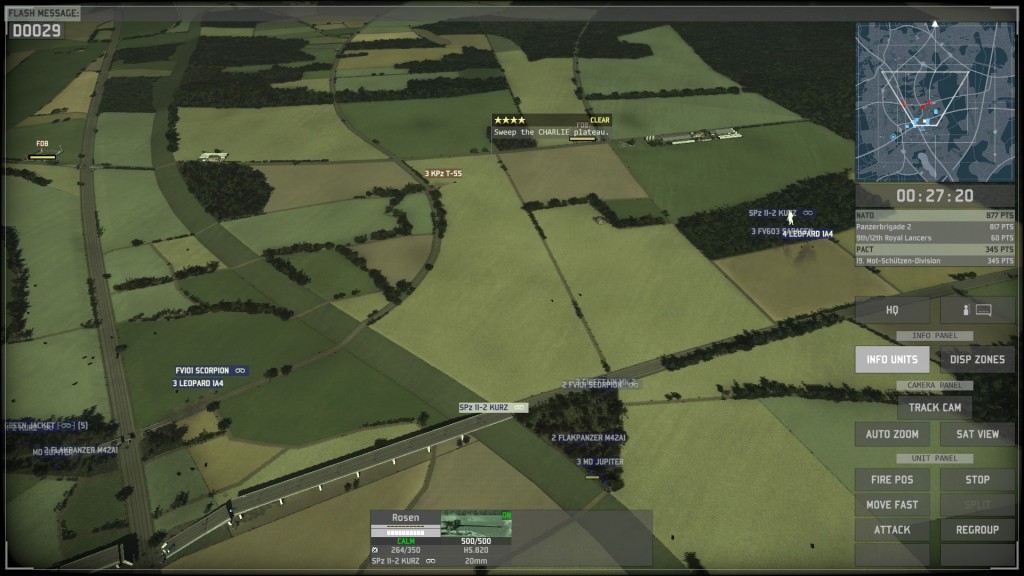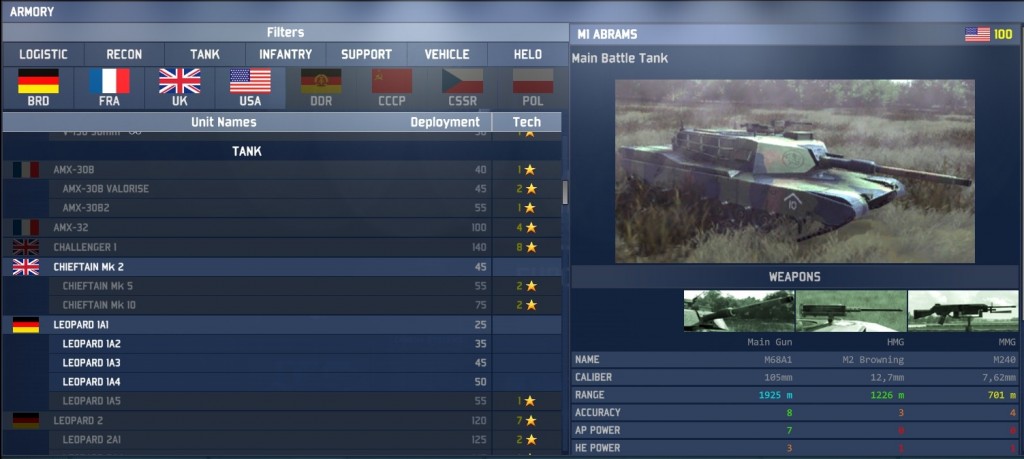- The Panzer General’s grandson: an introduction to Wargame: European Escalation
- Attack, defence, and the art of Wargame
- Wargame: European Escalation – The Verdict
- Wargame: European Escalation – 40% off sale & content patch
- What we know about Wargame: AirLand Battle
- Wargame: AirLand Battle: opening a box of virtual chocolates
- Wargame: AirLand Battle: right troops, right place, right time
- Let’s defend Scandinavia in Wargame: AirLand Battle! Part 1: Something Rotten in Denmark
- Let’s defend Scandinavia in Wargame: AirLand Battle! Part 2 (FINAL): Who Dares, Wins
- Wargame: AirLand Battle — The Verdict
- If your Wargame ain’t broke…
- The Beginner’s Guide to Wargame

It took a lot to drag me away from Crusader Kings 2; “ a lot” came in the form of Wargame: European Escalation, the Cold-War-gone-hot RTS from RUSE developer Eugen Systems. I’m still climbing its learning curve, but I’ve played enough to get a decent taste of its campaign, multiplayer, and to a lesser extent, skirmish modes. Several things stand out:
Simulation meets accessibility
Just as Panzer General did for the mid-nineties, Wargame: European Escalation does for 2012. Specifically, it’s a beer-and-pretzels wargame, a title that combines real-world principles such as morale, logistics, visibility, and flanking with a sleek, approachable RTS veneer. Terrain matters: driving along a highway is faster, but leaves you vulnerable to anyone lurking nearby, while forests can provide shelter for special forces raids. Think a deeper version of the tactical battles in Total War, one that also allowed you to call on reinforcements in mid-battle.
For example, take the above screenshot, from the second level of the campaign. My units are blue; the computer’s, in brown. My attack is occurring along three prongs: I have tanks pushing up from the left and the centre, but on the right, hidden by the forest, I have another mixed force of tanks and infantry ready to move up and hit the enemy in the flank. Tanks have much weaker armour on their sides than on their fronts, so this works just as well as it does in Total War. This was a huge risk, because I’d have been unable to see anyone hidden in the middle of the forest – and tanks are horribly vulnerable to point-blank ambushes – but it paid off! If I’d simply charged up the road in the middle, things would have gone much less well. Note the enemy tanks in the hedgerow at the upper middle of the picture – a frontal assault may very well have led to me being the one taking fire from the sides.
Just as important are the other supporting units. Recon units, the ones with the binoculars next to their names, are vital to spotting ambushes and keeping an eye on the enemy’s movements – and in this game, if you can see a unit, you can probably kill it. Anti-tank missile teams can make short work of even the most expensive tanks, but tend to carry little ammo and can’t shoot on the move. Artillery is horribly inaccurate when fired blindly, but when someone – such as those guys with binoculars! – has a line of sight on their target, an artillery barrage can stun, panic, or disorient defenders, and kill the lightly armoured ones outright… such as, say, those anti-tank crews. Helicopters are target practice if you have good anti-aircraft units, and murder if you don’t. What happens if I aim my best artillery not at the other guy’s tanks, but at his AA? Supply trucks and helicopters are unglamorous, but resupplying fuel and ammunition is vital.
Unit variety/unlocks

Real-world tactics demand real-world units, and Wargame’s metagame revolves around unlocking these. Completing campaign objectives or playing multiplayer (not skirmish!) matches will earn stars, and different units have a varying cost in stars to unlock. Normally I would not be a fan of this; however, earning stars is quick enough for me not to mind.
So, how many units are there in all? According to Eugen, the answer is over 350: light tanks, heavy tanks, old tanks, new tanks, jeeps, scout cars, mortars, artillery, rocket artillery, recon helicopters, attack helicopters, infantry in personnel carriers, infantry in transport helicopters… These vary across a range of dimensions: weapons, armour, accuracy, speed, fuel/ammo capacity, and cost in deployment points. Even accounting for duplicates and units that occupy the same niche, that is a lot of choices. Some are clearly over- or under-powered for their cost, but Eugen’s balance patches are chipping away at this list. Most are situational, and this is the beauty of the unlock system. Stars are abundant enough for me to have lots of cool toys to play with, but not so abundant that I have every cool toy to play with, which forces me to make interesting decisions even before I begin a match.
The single-player campaign
Wargame includes a 22-mission campaign, divided into four smaller sub-campaigns (which you have to play in sequence). So far I’m up to the fifth mission, and I think the best way to describe these would be “challenges”.
The campaign missions are challenges in two senses. First, they’re difficult. Usually, but not always, they require driving the computer from specified locations; this can be tricky for several reasons. First, the computer is often well dug in. Second, while there is no formal time limit to attack (though winning in X time can be a bonus objective), finite supplies impose a practical limit – turtle too long and you could run low on ammo. Third, you have to keep casualties down: there are only finite troops available in each mini-campaign, and keeping units alive from mission to mission allows them to gain experience (once again, a la Panzer General). Fourth, the computer can counterattack – in one mission I didn’t cover my flanks, leading to the enemy rolling up my supply lines and almost wiping me out! I won that mission in the end, but it was by the skin of my teeth: a crazy drive by a single command jeep to the victory objective*. The net effect is that after the first mission (effectively a tutorial), I’ve really had to work for each victory.
Second, the campaign feels as though the game designers have set me a string of problems, each of which is meant to teach me something. “Peter,” Professor Wargame says when I play the campaign, “the computer is dug into positions A, B and C, and it’s scripted to do X, Y, and Z. Given this set of tools, how would you achieve your objective?” And it succeeds at this. At the end of each mission, win or lose, I tend to walk away feeling as though I’ve learned something about modern military tactics. There is an element of hindsight involved when I replay missions, but so far, I feel as though I could have won the first time through with better tactics. For example, the three-pronged attack in the screenshot at the top followed my belated discovery of the perils of a frontal assault, and “okay, I’ll come under attack from this direction, so I’d better place some tanks over there!” could have been avoided had I kept scouts on all approaches. (I’m avoiding the word ‘puzzle’, which implies there’s only one solution to each mission; in a game with this many units, there has to be more than one.)
Note that the campaign is effectively story-less. A brief cutscene outlines the premise of each mini-campaign, but from mission to mission the context is limited to a narrator intoning that the BAOR has entered the fray or that NATO forces are attempting to encircle the Eighth Guards Army. I don’t mind; RTSes aren’t known for their writing anyway.
Skirmish and multiplayer
The skirmish and multiplayer modes feel very distinct from the more rigid campaign. Here, each team starts on opposite sides of the map, with an equally-sized pool of deployment points. There are objective areas scattered around the map, but ultimately the goal is to kill more of the enemy than you lose yourself – victory goes either to the side that first kills X points of units, or to the side with the greater kill score when the timer runs out. Lastly, whereas the campaign specifies the unit types available but lets you add as many as you can afford, skirmish/MP limits you to taking up to 25 different types (your “deck”) into a game.
The skirmish mode (limited to 1v1 matches) is passable, from what little I’ve seen. The skirmish AI plays a lot like an inexperienced human! I’ve seen it drive tanks too close to potential ambush locations, and I recently saw the AI open by spamming helicopters –terrifyingly effective against my initial line-up, but a game-loser once I responded with massed anti-aircraft units. However, these are the sorts of things that newbie players do – I know I’ve made the same mistakes – and as such, I’m not going to cast stones at the AI quite yet. The bigger problem with skirmish, as noted above, is that this mode doesn’t award stars for unlocking units. In other words, you cannot play this as a pure skirmish game. You’ll have to earn stars via the campaign, multiplayer, or both. This has been changed in a patch.
Multiplayer is where I’ve spent the most time. Rather annoyingly, the game often crashes while I’m trying to find/start a match, though it’s rock-solid once play begins. However, the quality of the MP gameplay is good enough for me to forgive the developers. The variety of units, the unlock system, the large map sizes, and the emphasis on tactics combine to create a plethora of interesting decisions: if I unlock this and that, could they form the hammer and anvil of an attack force? Do I hold at this juicy objective, or do I look for a more defensible position that brings in fewer deployment points? How do I ensure my deck can counter this common tactic? Hey, that guy rolled over me with an army of this! What should I unlock to counter it? And what do I have to jettison from my deck in order to make room?
Note that comp stomps aren’t currently in the game – for now MP is strictly PvP. However, Eugen has stated that it’ll patch this feature in within the month, so I look forward to trying it out. Comp stomps have now been patched in.
At this stage, I expect I’ll focus more on multiplayer than on the campaign. While the campaign feels cerebral, so does a maths lesson; I personally prefer the fluidity of multiplayer. However, the campaign’s style of gameplay could be more to others’ liking.
Stay tuned for further updates!
* It’s for this reason that I don’t believe the common forum assertion that the AI is omniscient. If it were, surely it would have pounced on my poor jeep?
